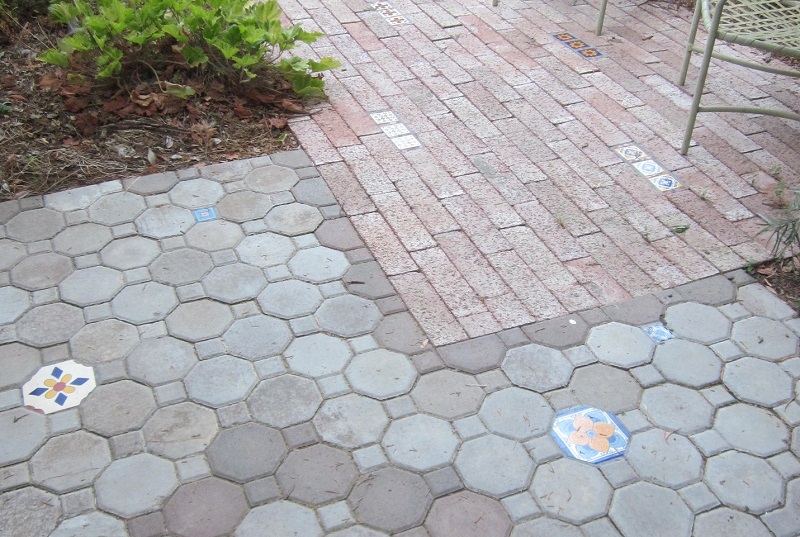The Merits of Using Salvaged and Upcycled Materials in Your Landscape Projects
The Japanese phrase “wabi sabi” means, generally, to embrace the imperfections of the world around us and to appreciate the character, charm, and uniqueness of things as they age. When applied to garden design, it highlights many of the reasons you may want to incorporate used materials in your landscaping efforts. Whether the wabi sabi philosophy appeals to you, you enjoy the challenge of finding creative ways to use salvaged materials, you want to reduce your environmental footprint by reusing and upcyling re-claimed materials, or you simply hope to save a buck, employing used materials in your landscape makes sense.
There are two primary ways used materials can be brought into your landscape. One is to simply use a design element in its present form. An old bench under your tree immediately creates a unique, comfortable look with an established sense of place that a new bench cannot duplicate. Or you can construct an element from used materials. A bird feeder or a new gate can be made from salvaged materials that started out looking nothing like its final form. In either case, you can choose the degree of “age” you want to express. Your old bench need not look like it lived in the back of a shed for the last 20 years. A coat of paint will freshen it up, maybe help compliment the other colors in your garden yet still not look like it just came from a big box store.
Another advantage of using salvaged materials is that it can inspire creativity. The small patio pictured here uses both old concrete pavers and bricks salvaged from a fireplace. There was not enough of either to cover the intended area. You may or may not like this particular look, but it does have a design element missing from a patio constructed with a single material. Garden sculpture created from used materials is a completely open creative exercise.
Challenges of Using Reclaimed Materials
Working with used materials does present some challenges. While there are many sources, as listed below, acquiring used materials is generally not as easy or convenient as going to the store to purchase new items. You may need to wait a while until the material or item you want shows up. You may need to store materials while you collect enough for the project you have in mind. Of course, nothing says your project must be created entirely of used materials. It may make perfect sense to purchase some new materials to mix in with the used to move things along. Used materials may not be as uniform or easy to work with as new materials. They may require more preparation. You may not find the same variety available as you would in a store. But with a little persistence, creativity, and flexibility you can develop an attractive, unique, functional, and cost-effective landscape project from recovered and reclaimed materials.
A Few Specific Uses
- Used bricks – pathways, patios, retaining walls, raised beds, plant stands
- Broken concrete (often called urbanite) – pathways, patios, retaining walls
- Redwood or cedar fence boards – raised beds, bird houses, bird feeders, accent fencing, and gates
- Poly barrels – water retention, large planters when cut in half
- Dismantled bedframes – trellises, metal posts for any number of uses
- Large cooking pots and similar vessels – plant pots
- Clay pipe – plant stands
- Pallets – tables and benches
- Pressure treated wood and railroad ties – retaining walls, steps (best not to use for raised beds, especially any bed that may hold vegetables)
- Old tires (painted or not) – plant containers, small water features, retaining walls
Specific Examples







Sources of Used Materials or Items
The opportunities to use recycled and reclaimed materials in your landscaping projects are varied and essentially endless. Some sources for materials include:
- Secondhand stores
- Yard sales
- Big Blue Barn at the Yolo Landfill
- Aggie Surplus
- Habitat for Humanity Restores and other used building material outlets
- Craig’s List, Freecycle, Next Door, eBay etc.
- Dumpsters at construction sites (ask for access)
- Davis apartment move-out donation stations
Whatever you create will be uniquely yours and do a bit to reduce your environmental footprint as well.
Resources
The Revolutionary Yardscape: Ideas for Repurposing Local Materials, Matthew Levesque, 2010
Sustainable Landscape Construction, 3rd Edition, Kim Sorvig and J. William Thompson, 2018
Special thanks to Bernadette Balics, Ecological Landscapes Design, Davis
Crossposted from the 2019 Fall issue of the Yolo Gardener, a publication of the UCCE Master Gardener Program of Yolo County. Download this article and others at http://yolomg.ucanr.edu/Yolo_
FACEBOOK FEED
Photos from Cool Davis's post ... See MoreSee Less
Stand with Cool Davis! The Cool Davis board of directors is working hard to move our organization towards a future that belongs to everyone. Anyone — friends, family, neighbors, organizations, and businesses – can donate starting TODAY, April 18 through midnight May 2, 2024, to support the work of Cool Davis in the community. Small amounts can make a big difference! #bdog2024
Kerry Daane Loux Kristin Heinemeier LisaABaker, Jason Bone, Ken Kirsch MAK Design+Build Inc. Christine Granger Matt Price Rekha Vaitla Johannes Troost www.bigdayofgiving.org/cooldavis
... See MoreSee Less






